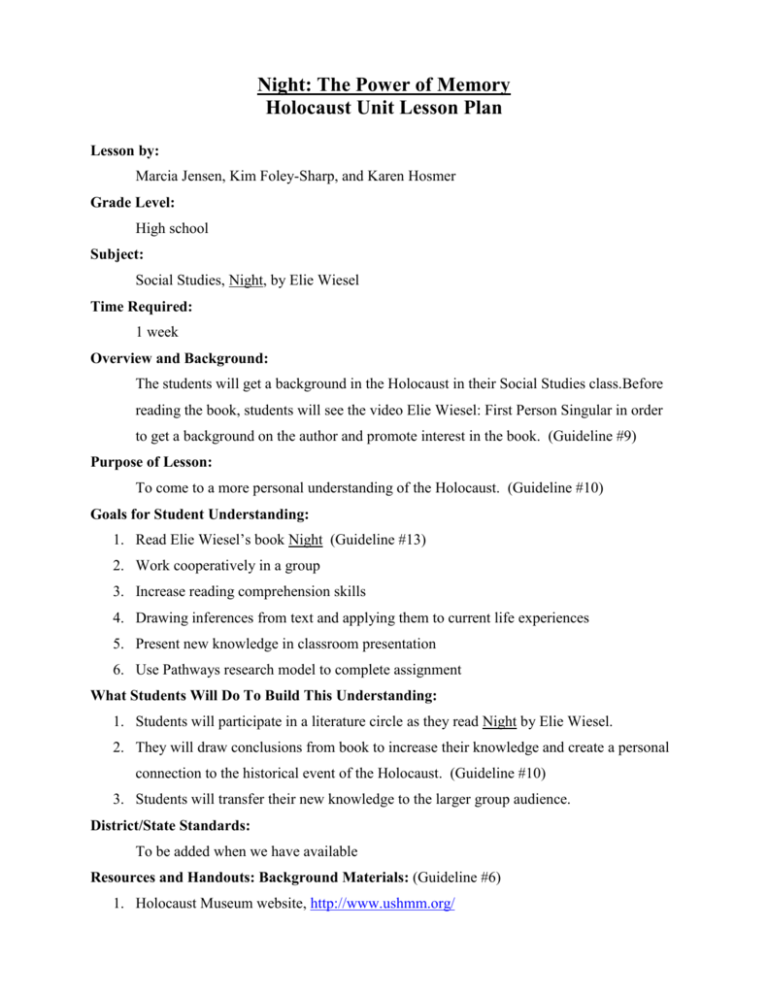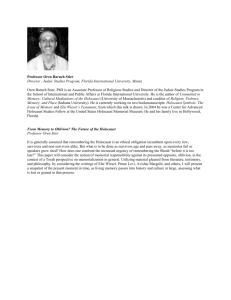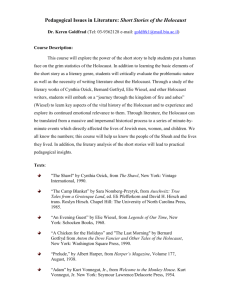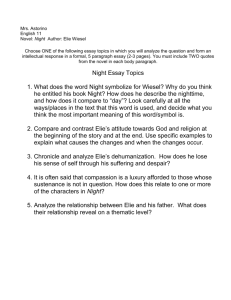Holocaust Unit for High School Social Studies by marcia Jensen
advertisement

Night: The Power of Memory Holocaust Unit Lesson Plan Lesson by: Marcia Jensen, Kim Foley-Sharp, and Karen Hosmer Grade Level: High school Subject: Social Studies, Night, by Elie Wiesel Time Required: 1 week Overview and Background: The students will get a background in the Holocaust in their Social Studies class.Before reading the book, students will see the video Elie Wiesel: First Person Singular in order to get a background on the author and promote interest in the book. (Guideline #9) Purpose of Lesson: To come to a more personal understanding of the Holocaust. (Guideline #10) Goals for Student Understanding: 1. Read Elie Wiesel’s book Night (Guideline #13) 2. Work cooperatively in a group 3. Increase reading comprehension skills 4. Drawing inferences from text and applying them to current life experiences 5. Present new knowledge in classroom presentation 6. Use Pathways research model to complete assignment What Students Will Do To Build This Understanding: 1. Students will participate in a literature circle as they read Night by Elie Wiesel. 2. They will draw conclusions from book to increase their knowledge and create a personal connection to the historical event of the Holocaust. (Guideline #10) 3. Students will transfer their new knowledge to the larger group audience. District/State Standards: To be added when we have available Resources and Handouts: Background Materials: (Guideline #6) 1. Holocaust Museum website, http://www.ushmm.org/ 2. Oprah Winfrey show with Elie Wiesel as they visit Auschwitz, http://www.oprah.com/obc_classic/featbook/night/obc_featbook_night_main.jhtml 3. Questions for adults: http://www.oprah.com/obc_classic/featbook/night/book/book_questions_01.jhtml 4. Elie Wiesel Foundation for Humanities: http://www.eliewieselfoundation.org/ Resources and Handouts: Materials Used (Guideline #6) 1. The life and work of Elie Wiesel: http://www.pbs.org/eliewiesel/life/index.html Video – First Person Singular, PBS 2. Timeline - Developed in collaboration with the United States Holocaust Memorial Museum: http://www.oprah.com/obc_classic/featbook/night/holo/holo_timeline.jhtml 3. Night teacher’s guide: http://images.oprah.com/images/obc_classic/book/2006/night/night_teachers_guide.pdf 4. Night reading questions for high school students: http://www.oprah.com/obc_classic/featbook/night/book/book_questions_03_print.jhtml 5. Bookmark of historical milestones of the Holocaust: (Guideline #9) http://www.oprah.com/obc_classic/featbook/night/book/book_bookmark.jhtml 6. Glossary terms found in book: (Guideline #5) http://www.oprah.com/obc_classic/featbook/night/book/book_glossary_01.jhtml 7. Audio version available at Quad-linc (Quad Cities on-line library resource) for students with reading difficulties: http://qls.rbls.lib.il.us/uhtbin/cgisirsi/BE6i7Kw6hj/QLL/298120301/60/1180/X 8. Holocaust: In Memory of Millions: Walter Cronkite chronicles the entire story of the Holocaust-- from the rise of the Nazi party and their plan to exterminate the Jewish people, to tales of incredible bravery among Holocaust survivors and those who liberated the concentration camps. Combines original footage and personal photographs with oral histories by those who survived. Video 90 minutes. http://qls.rbls.lib.il.us/uhtbin/cgisirsi/93SLh3MGFm/QLL/298120301/123 Lesson Narrative: Day 1 – Review definition of the Holocaust: The Holocaust refers to a specific genocidal event in twentieth-century history: the statesponsored, systematic persecution and annihilation of European Jewry by Nazi Germany and its collaborators between 1933 and 1945. Jews were the primary victims—6 million were murdered; Gypsies, the handicapped, and Poles were also targeted for destruction or decimation for racial, ethnic, or national reasons. Millions more, including homosexuals, Jehovah’s Witnesses, Soviet prisoners of war, and political dissidents, also suffered grievous oppression and death under Nazi tyranny. (Guideline #1) Present a biography of Elie Wiesel and show the video. (Guideline #9) Talk about literature circle procedures and form groups. Have groups decide on their reading schedule. Day 2: First discussion of literature circle. (Guideline #9) Day 3: Second discussion of literature circles. (Guideline #9) Day 4: Third discussion of literature circles. (Guideline #9) Day 5: Plan and create the visual presentation for the class. (Guideline #9 & 14) Day 6: Present to class. (Guideline #9 & 14) Assessment: Daily points for participation in literature circles. Group presentation using some visual media that will express their personal understanding of the Holocaust gained from the literature circle and classroom discussion; rubric given to students (created with the Social Studies teacher) (Guideline #14) Instructions for Student: Assignment 1 You will be working in a group to read and discuss the book Night by Elie Wiesel. You will use the process we have discussed to work in literature circles. Assignment 2 When you are finished, your group will put together a visual presentation that represents a personal understanding of the Holocaust that you gained from reading and discussing this book. artpitz@hotmail.com








